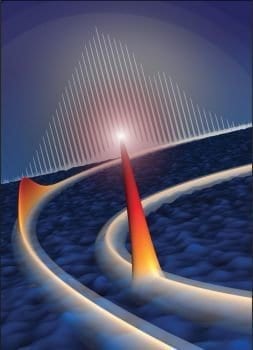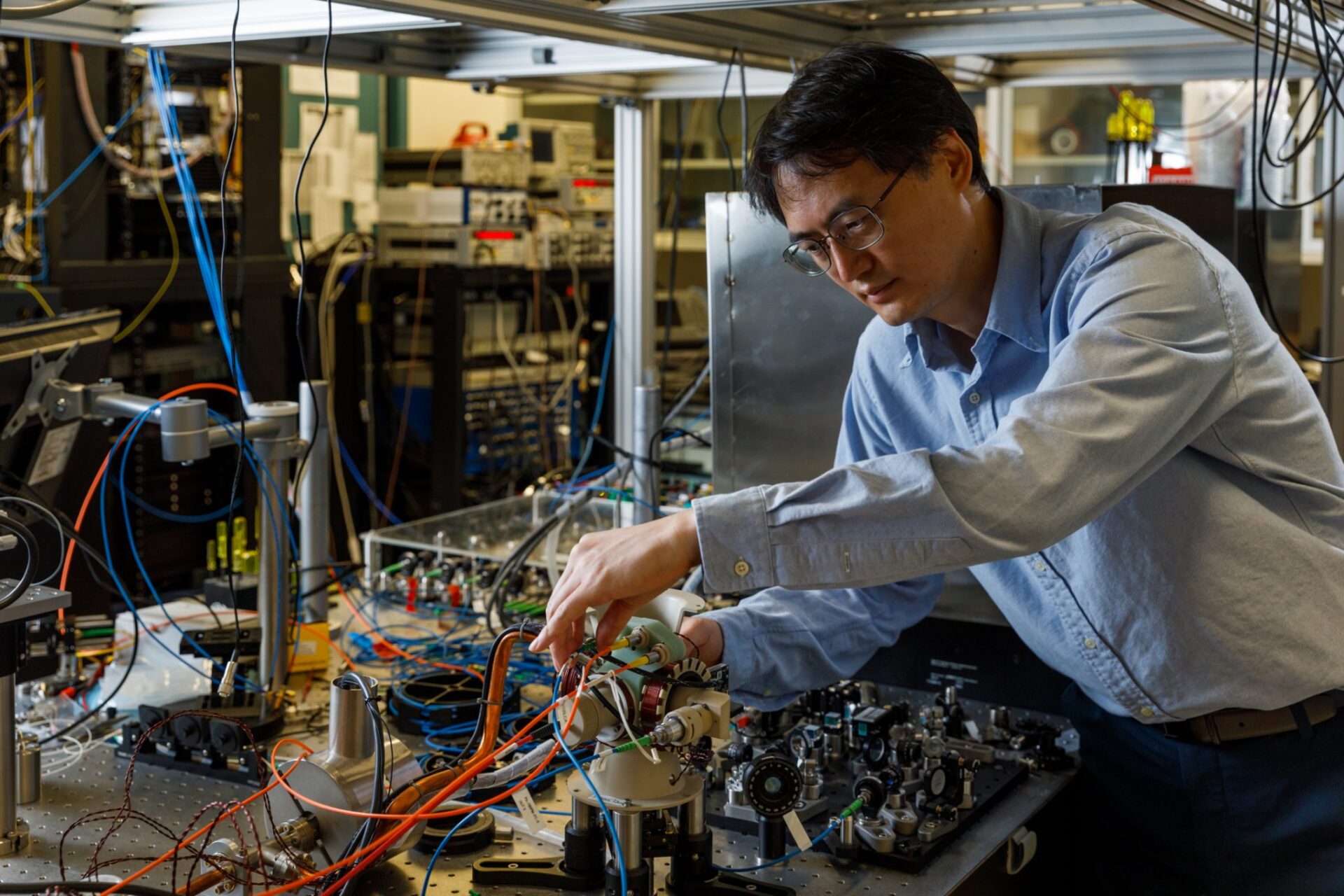
Scientists in the Emergent Photonics Lab (EPic Lab) at the University of Sussex have made a breakthrough to a crucial element of an atomic clock – devices which could reduce our reliance on satellite mapping in the future – using cutting-edge laser beam technology. Their development greatly improves the efficiency of the lancet (which in a traditional clock is responsible for counting), by 80% – something which scientists around the world have been racing to achieve.
Currently, the UK is reliant on the US and the EU for the satellite mapping that many of us have on our phones and in our cars. That makes us vulnerable not only to the whims of international politics, but also to the availability of satellite signal.
Dr Alessia Pasquazi from the EPic Lab in the School of Mathematical and Physical Sciences at the University of Sussex explains the breakthrough: “With a portable atomic clock, an ambulance, for example, will be able to still access their mapping whilst in a tunnel, and a commuter will be able to plan their route whilst on the underground or without mobile phone signal in the countryside. Portable atomic clocks would work on an extremely accurate form of geo-mapping, enabling access to your location and planned route without the need for satellite signal.
“Our breakthrough improves the efficiency of the part of the clock responsible for counting by 80%. This takes us one step closer to seeing portable atomic clocks replacing satellite mapping, like GPS, which could happen within 20 years. This technology will changes people’s everyday lives as well as potentially being applicable in driverless cars, drones and the aerospace industry. It’s exciting that this development has happened here at Sussex.”
Optical atomic clocks are at the pinnacle of time measuring devices, losing less than one second every ten billion years. Curently though, they are massive devices, weighing hundreds of kilograms. In order to have an optimal practical function that could be utilised by your average person, their size needs to be greatly reduced whilst retaining the accuracy and speed of the large-scale clocks.
In an optical atomic clock, the reference (the pendulum in a traditional clock) is directly derived by the quantum property of a single atom confined in a chamber: it is the electromagnetic field of a light beam oscillating hundreds of trillions of times per second. The clock counting element required to work at this speed is an optical frequency comb – a highly specialised laser emitting, simultaneously, many precise colours, evenly spaced in frequency.
Micro-combs bring down the dimension of frequency combs by exploiting tiny devices named optical microresonators. These devices have captured the imagination of the scientific community world-wide over the past ten years, with their promise of realising the full potential of frequency combs in a compact form. However, they are delicate devices, complex to operate and typically do not meet the requirement of practical atomic clocks.
The breakthrough at the EPic Lab, detailed in a paper published today (Monday 11 March) in the journal, Nature Photonics, is the demonstration an exceptionally efficient and robust micro-comb based on a unique kind of wave called a ‘laser cavity soliton’.
Dr Pasquazi continues “Solitons are special waves that are particularly robust to perturbation. Tsunamis, for instance, are water solitons. They can travel unperturbed for incredible distances; after the Japan earthquake in 2011 some of them even reached as far as the coast of California.
“Instead of using water, in our experiments performed by Dr Hualong Bao, we use pulses of light, confined in a tiny cavity on a chip. Our distinctive approach is to insert the chip in a laser based on optical fibres, the same used to deliver internet in our homes.
“The soliton that travels in this combination has the benefit of fully exploiting the micro-cavities’ capabilities of generating many colours, whilst also offering the robustness and versatility of control of pulsed lasers. The next step is to transfer this chip-based technology to fibre technology – something that we’re exceptionally well-placed at the University of Sussex to achieve.”
Learn more: Sussex scientists one step closer to clock that could replace GPS and Galileo
The Latest on: Portable atomic clock
[google_news title=”” keyword=”portable atomic clock” num_posts=”10″ blurb_length=”0″ show_thumb=”left”]
via Google News
The Latest on: Portable atomic clock
- Vector Atomic makes waves with ultra-precise, seafaring atomic clockon April 28, 2024 at 1:54 am
The true marvel lies in the clock’s accuracy. Vector Atomic claims it surpasses the performance of existing shipboard clocks by a staggering 1,000 times. This translates to significantly improved ...
- Scientists create new atomic clock that is both ultra-precise and sturdyon April 26, 2024 at 6:35 am
A team of physicists and engineers at Vector Atomic, Inc., a maker of navigation and communications equipment, has developed a new kind of atomic clock that they claim is both ultra-precise and sturdy ...
- NPL working with ESA to SWAP all the clockson April 25, 2024 at 5:00 pm
The National Physical Laboratory is working with the European Space Agency to develop portable optical atomic clocks for the next generation of Position, Navigation and Timing (PNT) satellites. NPL's ...
- NPL and ESA collaborate on next gen PNT techon April 25, 2024 at 4:56 am
The Teddington based National Physical Laboratory (NPL) is working in collaboration with the European Space Agency's (ESA) Navigation Innovation Support Programme (NAVISP) and the UK Space Agency ...
- NPL joins ESA and UKSA to develop next-gen PNT technologieson April 24, 2024 at 5:00 pm
One solution is to develop robust, portable optical clocks with low size, weight and power (SWAP) which have better accuracies than microwave systems. Space-deployable cubic optical cavity technology ...
- NPL and ESA to develop next generation of PNT technologieson April 24, 2024 at 4:25 am
The National Physical Laboratory (NPL) has announced that it is working in collaboration with the European Space Agency's (ESA) Navigation Innovation Support Programme (NAVISP) and the UK Space Agency ...
- How gliding marsupials got their ‘wings’on April 23, 2024 at 5:00 pm
Several marsupial species have evolved a membrane called a patagium that allows them to glide gracefully from tree to tree. Experiments show that mutations in areas of DNA around the gene Emx2 were ...
- Atomic clock keeps ultra-precise time aboard a rocking naval shipon April 23, 2024 at 5:00 pm
The best timepieces tend to be fragile, but a device based on iodine threads the needle between precision and practicality.
- New method may make more precise and portable atomic clocks possibleon April 23, 2024 at 10:16 am
At the Niels Bohr Institute in Copenhagen, a descendant of its namesake has devised a method to enhance the precision of top atomic clocks.
- Superradiant atoms could lead to more accurate atomic clockson April 23, 2024 at 7:43 am
Moreover, atomic clocks use radio waves to constantly synchronize various devices, including computers, phones, and wristwatches. As per the press release, these modern atomic clocks rely on lasers to ...
via Bing News










